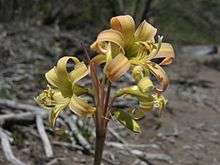Rhodophiala
Rhodophiala is a genus of herbaceous, perennial and bulbous plants in the Amaryllis family (Amaryllidaceae, subfamily Amaryllidoideae[2]). It consists of about 30 South American species distributed in southern Brazil, Argentina, and, specially, in Chile.
| Rhodophiala | |
|---|---|
 | |
| Rhodophiala montana | |
| Scientific classification | |
| Kingdom: | Plantae |
| Clade: | Tracheophytes |
| Clade: | Angiosperms |
| Clade: | Monocots |
| Order: | Asparagales |
| Family: | Amaryllidaceae |
| Subfamily: | Amaryllidoideae |
| Subtribe: | Hippeastrinae |
| Genus: | Rhodophiala C.Presl.[1] |
| Type species | |
| Rhodophiala amarylloides | |
| Species | |
|
See text | |
| Synonyms | |
Description
Rhodophiala species resemble small-flowered Hippeastrum or multiflowered Habranthus species. Their narrow parallel-sided leaves are unlike that of Hippeastrum, more closely resembling that of Habranthus or Zephyranthes.[3]
Taxonomy
At one stage, Rhodophiala was considered a subgenus of the closely related Hippeastrum.[4]
Although as of February 2016 not yet accepted by the World Checklist of Selected Plant Families a number of species of Rhodophiala have been rehabilitated as Rhodolirium.[5][6]
Species
The World Checklist of Selected Plant Families accepts 27 species as of June 2013:[1]
- Rhodophiala advena (Ker Gawl.) Traub – Central Chile
- Rhodophiala ananuca (Phil.) Traub – Northern Chile
- Rhodophiala andina Phil. – Central Chile
- Rhodophiala araucana (Phil.) Traub – distributed Chile to Southern Argentina
- Rhodophiala bagnoldii (Herb.) Traub – Northern and Central Chile
- Rhodophiala bakeri (Phil.) Traub – Central Chile
- Rhodophiala berteroana (Phil.) Traub – Central Chile
- Rhodophiala bifida (Herb.) Traub – distributed Southern Brazil to Argentina (Buenos Aires)
- Rhodophiala biflora Phil. – Chile
- Rhodophiala colonum (Phil.) Traub – Southern Chile
- Rhodophiala consobrina (Phil.) Traub – Central Chile
- Rhodophiala flava (Phil.) Traub – Southern Chile
- Rhodophiala fulgens (Hook.f.) Traub – Central Chile
- Rhodophiala gilliesiana (Herb.) ined. – distributed Chile to Southern Argentina
- Rhodophiala lineata (Phil.) Traub – Chile
- Rhodophiala maculata (L'Hér.) Ravenna – Chile
- Rhodophiala moelleri (Phil.) Traub – Southern Chile
- Rhodophiala montana (Phil.) Traub – Chile
- Rhodophiala phycelloides (Herb.) Hunz. – Chile
- Rhodophiala popetana (Phil.) Traub – Central Chile
- Rhodophiala rosea (Sweet) Traub – Chile
- Rhodophiala splendens (Renjifo) Traub – Central Chile
- Rhodophiala tiltilensis (Traub & Moldenke) Traub – Central Chile
The following species, formerly in Rhodophiala have been transferred to Rhodolirium.[5][6]
References
- Search for "Rhodophiala". "World Checklist of Selected Plant Families". Royal Botanic Gardens, Kew. Retrieved 2013-06-15.
- Stevens, P.F. "Angiosperm Phylogeny Website: Asparagales: Amaryllidoideae". Retrieved 2013-06-15.
- Castillo, A. (2003). "Rhodophiala". Pacific Bulb Society. Retrieved 2013-06-15.
- Baker, John Gilbert (1888). "Hippeastrum". Handbook of the Amaryllideæ including the Alstrœmerieæ and Agaveæ. London: Bell. p. 41. Retrieved 31 March 2014.
- Munoz et al 2011.
- Garcia et al 2014.
Bibliography
- García, Nicolás; Meerow, Alan W.; Soltis, Douglas E.; Soltis, Pamela S. (1 March 2014). "Testing Deep Reticulate Evolution in Amaryllidaceae Tribe Hippeastreae (Asparagales) with ITS and Chloroplast Sequence Data". Systematic Botany. 39 (1): 75–89. doi:10.1600/036364414X678099.
- Muñoz, Manuel; Riegel, Ricardo; Seemann, Peter; Peñailillo, Patricio; Schiappacasse, Flavia; Núñez, José (2011). "Relaciones filogenéticas de Rhodolirium montanum Phil. y especies afines, basadas en secuencias nucleotídicas de la región ITS y análisis cariotípico". Gayana. Botánica. 68 (1): 40–48. doi:10.4067/S0717-66432011000100005.
- Letelier, Patricia; Cabello, Ángel (December 2013). "Descripción de bulbos y hojas de Rhodophiala tiltilensis (Traub & Moldenke) Traub, y propagación vegetativa" (PDF). Revista del Jardín Botánico Chagual (in Spanish). 11 (11): 72–78.
External links
| Wikimedia Commons has media related to Rhodophiala. |
| Wikispecies has information related to Rhodophiala |